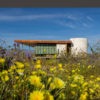No spectators
Leave no trace
Piss clear
Subvert yourself
It is a town like any other. Lampposts line every street. The city center bustles with public activities. Radio stations and multiple daily newspapers keep its citizenry informed of current events. It has a DPW and a DMV. It has a post office and an airport. It has suburbs.
It is a town unlike any other. There are no elected officials. Its plan is circular. Everyone builds his or her own place to live. There is virtually no crime. There are no businesses or employers. Art is not optional. There are no stores or restaurants; nothing is for sale. There is no television. There are no landlines or cell phones. There are no homeless. There are no guns. It has four Cacophony Societies and an Irrational Geographic Society. It has a Ministry of Statistics. It has grown from 30 to 30,000 people over the last 15 years. Its inhabitants are diverse in age, ethnicity, gender, wealth, sexual orientation and occupation. They are well educated and politically active. They regularly engage each other in meaningful conversation and rituals. There are no taxes. There are no malls. There are no museums.
What began as an individual act on a beach in San Francisco in 1986 has grown to be a festival of individual and collective actions with upward of 30,000 participants. Relocated to the desert salt flats of Nevada, the city of Black Rock has grown out of the necessity to accommodate such numbers. In this way, the city has its base in creativity, experimentation, and inclusion. In the coming together around creative expression, this default town has become an operational city: exhilarating, temporary and contagious.
Although there are many levels of meaning to Burning Man ranging from the personal to the communal, the survival and success of this three-day to three-week annual event are based on several principles of behavior that are promoted as mottoes. They become mantras of the playa.
No Spectators
Black Rock is a city based on participation. From constructing a tent to burning The Man (the annual 40- foot-high effigy in wood, neon and fireworks), individuals and organized groups of volunteers decide what to do. Then they do it. As the festival and town have grown, a seven-member board has formed to manage the project year-round, organizing infrastructure, serving as liaison to the federal Bureau of Land Management and local authorities, disseminating information and selling tickets. Apart from the basic services organizers and volunteers may be providing, such as street lamps, portable toilets, and The Man, citizens must make and do the remainder of what it takes to round out the town. From the Alternative Energy Zone and Kids’ District to the post office and art car taxi service, if it’s there, someone schemed, concocted and brought it to the playa.
As one participant tells aspiring citizens, “If you build it, you can come.” Translated to the scale of a city, this policy of self-reliance promotes volunteerism and neighborliness. Collaboration prevails and creativity is rewarded.
As with the other mottoes of Burning Man, “No Spectators” speaks more about social behavior than physical regulations, but the implications on the built environment are enormous. Out of the vast- ness of the desert, an urban density is maintained to facilitate interaction. Black Rock is an experiment in inclusionary town planning. With variations from year to year, a circular plan is laid out with vital services and a pedestrian-only civic plaza at its center. Surrounding neighborhoods with support services are created based on themed districts. There are no set stages or performance areas; events occur spontaneously in any suitable location. In this town teeming with activity, it is impossible to “see everything,” but one can “participate in anything,” anywhere in town. Such an arrangement encourages movement, curiosity and verbal exchange.
To ensure active participation and basic safety, Black Rock City is effectively a gated community. This gate serves as a defensible border against those not yet educated in its principles (no vending, no guns, etc.) and those unprepared for desert survival. It also choreographs and minimizes the number of vehicles traversing the open playa.
As the population of Black Rock City has grown, spontaneous suburbs have formed for special interests, greater and lesser amounts of noise, proximity to the airport and lower density. These suburbs, however, are conceived of as sub-Burns, smaller villages that maintain the same principles and components as Black Rock, but on a smaller scale. By purposefully keeping a significant density and incorporating outposts of Black Rock’s civic components, they maintain a close relationship to the city proper.
By encouraging involvement and promoting responsibility, both socially and physically, Black Rock creates a collaborative, participatory populace. It promotes equality, with favor based on inclusionary creative actions rather than conventional paradigms of social status. Experimentation and improvisation are commended. A great balance exists between the personal ownership involved in conceiving and producing everything from one’s house to one’s clothing and the collective pride of engaging in the shared experience of enjoying it all. A profound social experiment, Black Rock City exists as a critique of conventional life; it is subversive, progressive and dynamic.
Leave No Trace
In a place with no “They” (as in “Who will pick up all this trash? They will!”), “Leave No Trace” was initially intended to convey the sentiment that everyone must pack out what he or she packs in. But it expresses, as well, a broader sensitivity to and responsibility for the physical environment.
Black Rock’s commitment to the natural state of the playa encourages living lightly on the land as well as incorporating elements of the landscape into housing, costumes and interactive art installations. Perhaps most memorable have been a life-size copper raining tree, a fifteen-foot diameter ball of ice and the annual three-story earthen towers for operatic performance.
It isn’t that Black Rock citizens curb their more material ambitions. One need only recall the massive, communally playable musical monument of sixty pianos or the generator-powered metal shops for onsite manufacture of remote control flame-throwing devices. What differs from most societies is that individual creators adhere to a policy of responsibility beyond the so-called main event. There is a recognition that the event lies not only in the making, experimenting and enjoying, but also in the destruction and removal. The challenge is its own reward.
“Leave No Trace” is a motto widely employed in outdoor recreation of all types, but at Black Rock it sees a level of commitment of heroic proportion. Cleanup volunteers remain until the desert is fully restored to Bureau of Land Management or Burning Man standards—whichever are higher—often staying onsite for weeks after the main festival. A display of collected refuse, neatly packaged according to city block, was recently exhibited in San Francisco, providing perhaps the most complete lost and found service for any event in history.
Furthermore, what began as a simple principle of conduct has grown for many Black Rock citizens to be a major voice in state and federal land use legislation, lobbying for the protection of the Nevada desert. In this way, fiction and reality mutually inform one another. Similarly, once practiced on the playa, “Leave No Trace” returns to citizens’ home- towns with them, encouraging scrutiny of land use, relation to the elements and appreciation of place.
Piss Clear
Literally taken, “Piss Clear” refers to the empirical method of determining sufficient ingestion of water to defend against dehydration. More broadly, it advocates a monitoring of the body’s condition in a harsh environment. In a place where temperatures range from 50 to 110 degrees over the course of an average day and where blinding dust and rainstorms unpredictably invade the landscape, an architecture of survival is in order. At Black Rock, all structures must be portable, provide shade and air circulation, be wind resistant and temporary. Waterproofing and clothing are optional, creativity and sunscreen are not.
In a town without building regulations or permits, citizens build by trial and error, relying heavily on past experience and collaboration. There is no Department of Building Inspection. If there were, it would surely be something like a Department of Built Exceptions, its only bureaucratic form a published list of the many websites available on the topic of do-it-yourself structures. An atmosphere of pride, ownership and respect prevails.
Reflective of the fact that Black Rock has no hardware or lumber stores, its architectural design is eclectic and its structural design ingenious. A variety of structures populates the landscape, colorful hybrids of PVC pipe, trampolines and parachute cloth. Occasionally, a more traditional Bucky dome, yurt or teepee appears. Decorations range from flags and murals to solar-powered lights and elaborate moving projections. The ever-changing cityscape stands as homage to the spirit of improvisation, collaboration and will power. As a model, Black Rock offers encouragement for invention, self-reliance, collaboration and the dissemination of information.
Subvert Yourself
Certainly Black Rock City sidesteps many of the difficult issues of more permanent cities. By literally leaving a clean slate for itself, it is constantly able to rein- vent and reorganize. It has, however, successfully responded to significant civic challenges: in its unfailing commitment to radical free expression, in its meaningful accommodation of enormous increases in population and in its dealings with the very real demands of health and safety imposed by participants as well as local, state and federal governments. At the very least it is a thriving social and physical experiment that offers a model for extrapolation.
Black Rock City is a place to experiment with ideas communally, to act on imagination and to test personal limits. As when we wake, our dreams unfold and become part of who we are, a stay in Black Rock City renders an interior change of perspective. Its best lessons invite participation, promote appreciation of the environment and encourage an awareness of one’s responsibility in society. It prompts us to reflect on the mottoes we inscribe—and build—into our homes, offices, schools and town halls.
Author Jane Martin is principal of Shift Design Studio in San Francisco and a member of the architecture faculty at California College of Arts and Crafts. She has been a citizen of Black Rock City since 1995. She was a Danger Ranger at this year’s festival. Black Rock City convenes each year at Labor Day. See “www.burningman.com” for information on Black Rock City and the Burning Man Festival.
Aerial photo courtesy of the Burning Man Archives; photo of The Man by Maggie Hallihan.
Originally published late 2000, in arcCA 00.2, “Common Ground.”







